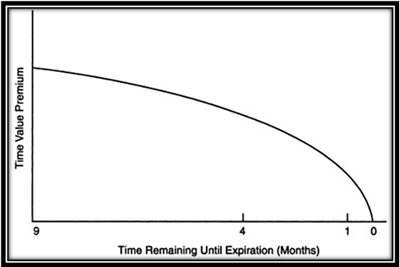It is important that we clearly understand what factors go into an options premium or value. If we blindly pick on what appears to be cheap options, we may get saddled with a dud. When picking apart the premium or cost of an option, we can separate them into two broad categories.
- Intrinsic value
- Time value
Others will categorise these two as intrinsic and extrinsic value.
I choose not to split hairs since we are discussing the very same thing.
Intrinsic Value
To calculate intrinsic value, figure out the difference between the strike price and the current share price. If you bought a call option with an $8 per share strike price, and the shares are trading at $10, you have an intrinsic value of $2 per share. The amount that the call option strike price is below the current price is the amount that it is ‘in the money’, or the intrinsic value.
For put options, the amount that the strike price is above the current price is the intrinsic value. If the stock is trading at $20 and your put options contract has a strike price of $25, the intrinsic value is $5 per share. This put contract would also be ‘in the money’.
The intrinsic value is the amount you will receive if you choose to exercise the option.
Time Value or Extrinsic Value
If instead of exercising the option you choose to resell the option, you should gain slightly more profit depending on the exact option you purchased. This added profit is extrinsic value – or the worth of the options contract itself. Why would the options contract be worth money? Because there is time value built into it.
Time is money. If you could immediately convert a contract into shares or speculate another 6 months hoping for share prices to further increase, which would be worth more? Of course the option that allows you more time to profit and trade.
How Much Is Your Time Worth?
How do we know the value of each tradable day in the options contract? Different pricing models are able to pick apart and determine the rate of decay, or the rate at which the option loses its value each day. But as a general rule, the last 30 days of an options life have the quickest decay.

Another rule of thumb is that an option will lose one-third of its value in the first half of its life, and it will lose the remaining two-thirds of its time value in the last half of its life. It is clear that from a purchasing point of view, options acquired with only a month or two of time value will deflate the quickest. So while buying very short term options might seem cheap, they could be a lot more expensive than they first appear.
What Ingredients go into Time Value?
It is possible to have two similarly priced stocks, with two identical options at the same strike price, time until expiration and so forth, and one will lose one cent per share daily while the other loses its value at a rate double that. How can this be possible?
For those interested, the amount an option loses value in one day is referred to by the Greek letter Theta. Time decay is based on a few different ingredients that may differ between stocks.
Understanding what goes into an options value is synonymous with knowledgeable trading that will eventually lead to an increased profitability.
| Important Fundamental Factors Influencing Time Value (also Theta) | |
|---|---|
| Historical Volatility | Option pricing will factor in the previous six months of a stocks movement. The greater the historical volatility, the more expensive the time value will be. The idea behind this is that the highly volatile stock has a much greater chance of a large price move leading to bigger profits. |
| Implied Volatility | This is also known as market expectation. If the stock or market is anticipated to go up, the call options will also go up regardless of previous price movements. |
| Time Until Expiration | The more time you buy the more expensive the option will be. |
| Dividend Payouts | Option holders do not receive dividends since they do not own the underlying asset. When a dividend is approaching, the stock will increase in value. When the dividend is paid out the stock should decrease by the value of the dividend. The option should be worth slightly less than normal in relation to the stock before the dividend since the option holder does not profit from it. |
| Interest Rates | Rising interest rates will also increase the value of time in the options premium. |